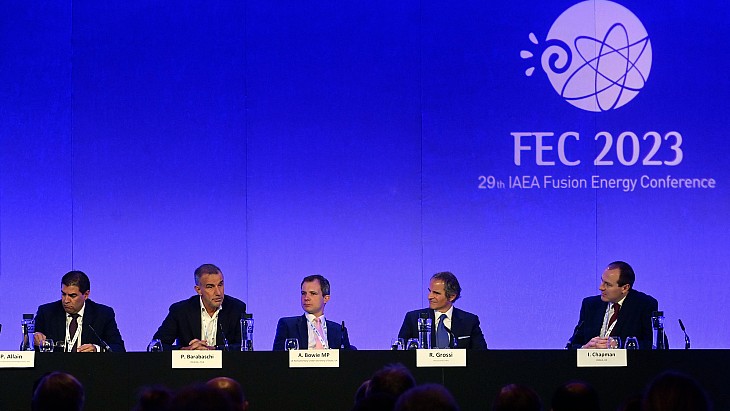Speaking at the 29th IAEA Fusion Energy Conference, he said a new timeline for the multinational project, in Cadarache in southern France, would be presented to the board for approval in the middle of next year.
The pandemic and the emergence of problems with the vacuum vessel sector's welding joint region and corrosion-induced cracks in thermal shield piping have meant that there has been a certainty that a considerable delay to the schedule will be needed, and he said "there is no way whatsoever of course that we're going to have first plasma in 2025 (the existing timeline set in 2016) but frankly speaking I think there was no way even three years ago" that it was going to be met.
Barabaschi said there had been a "change of culture" where they were conscious of the problems faced rather than them being swept "under the carpet" and overall "we are on a good track ... we are now in the process of preparing the new baseline, it will not be good news ... but we will go ahead and we will succeed. I am very sure about that".
In his update after his first year in the role, he said there had been a lot of progress, such as the power supply system being completed and the equipment largely installed for the pulsed-power electrical system, adding that civil works at the site were now 80% complete.
He said that all 19 toroidal field coils had been manufactured and 17 were now on site, with the final two in transport. Of the six poloidal field coils, the largest of which has a 24 metre diameter and weighs 400 tonnes, two are installed and one more is already on-site with the last due to be completed by the end of the year. The cooling water system has been commissioned and the system is operational, while the equipment installation for the cryogenic plant is complete and it has entered the pre-commissioning phase.
However, there have been challenges of first-of-a-kind components, he said - such as the first complete Vacuum Vessel Sector Module which was lifted into the tokamak pit in May 2022 but later had to be removed after "the sector-to-sector welding of Vacuum Vessel sectors was reassessed to be too challenging to perform in-situ, based on the previously identified geometric non-conformities in the field joints" and leakage was also identified in thermal shield cooling piping due to chloride stress corrosion. Repair contracts to address these "non-conformities" have been awarded.
Other issues to be considered in drawing up the revised project timeline, he said, were:
- "Ensuring alignment with ASN, the French nuclear safety regulator, in part by implementing a stepwise approach to safety demonstration" - he did not think it reasonable or possible to have a safety demonstration now to show the regulator that ITER would be safe at the end of its lifetime
- Rethinking the Vacuum Vessel welding sequence
- "Realistic timing for assembly and commissioning .. the previous one was not realistic - it's always aggressive the way we plan, but it should not be surreal"
- Begin testing some Toroidal and Poloidal Field coils
- Switching the First Wall material from beryllium to tungsten and "adjustments to scope of First Plasma, followed by two DT operational phases"
During the session at the conference in London, Barabaschi also outlined issues with finding the right skills and experience for the project when asked about knowledge management.
He said: "One of the biggest challenges we have in fusion is that throughout the construction of ITER a lot of knowledge has been lost - the knowledge about what it takes to integrate a facility like ITER, to design it from scratch, has been lost. I think we need to rebuild the knowledge - the knowledge is available somewhere but it is not consolidated."
By consolidated, he said, he meant to have "good design guidelines" which would be available to members and this would "be one of the most important outputs of ITER - not just the research infrastructure but the design guidelines and guidelines on how to fabricate and what to do and what not to do, the non-conformities, the handling of the non-conformities, these should be made available in a way which is accessible".
Engineers were not as good at consolidating information as scientists in fusion "because scientists publish much more than engineers do", he said, adding that not consolidating information was "a very serious problem and we have to change the culture - it is something we are going to do at ITER, with difficulties, because we will have to get some retired people back on board again, believe it or not" to do it.
ITER is a major international project to build a tokamak fusion device designed to prove the feasibility of fusion as a large-scale and carbon-free source of energy. The goal of ITER is to operate at 500 MW (for at least 400 seconds continuously) with 50 MW of plasma heating power input. It appears that an additional 300 MW of electricity input may be required in operation. No electricity will be generated at ITER.
Thirty-five nations are collaborating to build ITER - the European Union (plus Switzerland) is contributing almost half of the cost of its construction, while the other six members (China, India, Japan, South Korea, Russia and the USA) are contributing equally to the rest. Construction began in 2010.





_18570.jpg)
_18938.jpg)
_33584.jpg)
_82983.jpg)





